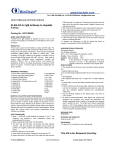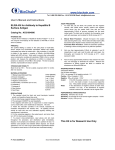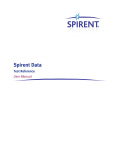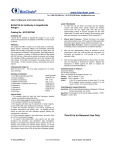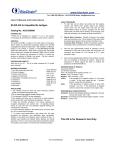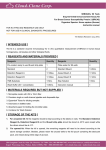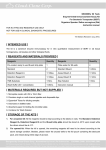Transcript
ELISA Kit for Antibody IgG to Hepatitis E Virus (HEV) Catalog No.: Z7010008 [NAME AND INTENDED USE] ***ELISA Kit for Antibody IgG to Hepatitis E Virus (HEV)*** is an in vitro enzyme immunoassay for the detection of Anti-HEV antibodies IgG in human serum or plasma. It is for diagnosis of early infection and epidemic survey. [PRINCIPLE] This kit uses indirect ELISA method to detect anti-HEV antibodies IgG in serum or plasma. The purified activated recombinant HEV antigen (ORF2、ORF3) is coated on the multi-wells plate. The HRP conjugated mouse anti human IgG (r chain) monoclonal antibody serves as tracer. TMB is substrate for HRP. The enzyme reaction with substrate TMB produces a color change, and the intensity of the absorbance at 450 nm indicates the presence or absence of Anti-HEV antibodies IgG in the sample. The test is specific, sensitive, reproducible and easy to operate. It is for blood screen of HEV infection. [INSTRUMENT] 8 x 12 wells plate reader and washer [MATERIALS PROVIDED] 96 tests 1. Antigen Coated Microwell Plate 2. Sample Diluent 3. Negative Control Serum 4. Positive Control Serum 5. Concentrated Wash Buffer (20x) 6. Enzyme Conjugant 7. Substrate A 8. Substrate B 9. Stop Solution 10. Plastic Bag 11. Seal Paper 12. Manual 7. Add enzyme conjugant 100 μl into the wells except the blank well, mix thoroughly. 8. Cover wells with seal paper, incubate for 20 minutes at 37°C. 9. Repeat step 6 10. Add 50 μl substrate A and B respectively to each well, mix gently, protected from light and lay aside for 10 minutes at 37°C. 11. Add 50 μl of stop solution into each well to stop the reaction, including blank well. 12. Measure the absorbance at 450 nm against the blank, or measure the absorbance at 450 nm/630-690 nm. [INTERPRETATION OF RESULTS] Colorimetric Method Cut Off Value calculation: COV = 0.1 + the average OD of negative controls, (if the average OD of negative controls is below or equal to 0.05, calculate it as 0.05), Positive OD450 of sample ≥ COV Negative OD450 of sample < COV [LIMITATION] The testing is for qualitative and assistant diagnosis. Confirmation of infection should refer to the clinical and other diagnosis. 1 block (96wells) 1 bottle (12ml) 1 vial (1ml) 1 vial (1ml) 1 bottle (50ml) 1 bottle (12ml) 1 bottle (6ml) 1 bottle (6ml) 1 bottle (6ml) 1 bag 2 pieces 1 each [SAMPLE COLLECTION AND PRESERVATION] Blood serum samples are routinely prepared form vein. Blood plasma sample are routinely prepared with routine amount of anticoagulant such as heparin or sodium citrate. Sample can be stored at 4°C if tested within five days. Sample can be stored at -20°C at least for 3 months. Avoid hemolysis and repetitive freeze and thaw of samples. Samples with cloud or precipitation should be centrifugated or filtered before test. Prevent serum from bacteria contamination during collection and storage. [TEST PROCEDURE] 1. Bring ELISA Kit for Antibody IgG to Hepatitis E Virus (HEV) (all reagents), and samples to room temperature before use (approximately 30 minutes). 2. Dilute concentrated wash buffer 1:20 with ddH2O 3. For each test, set one blank, two positive and three negative controls. Add 100 μl positive and negative control serum into positive and negative control wells respectively without sample diluent. 4. Add 100 μl sample diluent in each test wells, then at 10 μl test serum into test wells. Pipet up and down to mix the samples well. 5. Cover wells with seal paper, incubate for 20 minutes at 37°C. 6. Discard the liquid in all wells and fill the wells with wash solution (350μl per well). Lay aside for 15 seconds, discard the liquid in all wells and fill the wells with wash solution. Repeat 5 times and dry wells after last wash. [QUALITY CONTROL] If the OD of positive controls is not below 1.0, OD of negative is not higher than 0.1, the assay result is validated. Otherwise, repeat the test. [PRECAUTIONS] 1. The samples should be fresh, avoid hemolysis, bacteria growing, and repetitive freeze and thaw. 2. Do not interchange reagents between kit lots. The seal paper can’t be used repeatedly. 3. Mix reagents well before use. If crystal form in certain reagents, such as wash buffer, it can be used without problems after warm up and mix well. 4. Follow instruction exactly during assay, especially in temperature and time for reactions. All pipetting devices should be used with care and calibrated regularly following the manufacturer’s instructions. 5. Put the remained reagents to the sealed pouch, and return to 2~8°C in time. 6. To prevent cross-contamination, wear gloves and working suits throughout the procedure, and execute the disinfection and isolation regulations strictly. Dispose of all samples and materials used to perform the test. The 5.0g/L liquid sodium hypochlorite solution or 121°C high pressure steam may be used to disinfect samples and materials before disposal (The positive control serum in the kit has been inactivated already) [STORAGE AND STABILITY] Store the kit at 2~8°C. [EXPIRATION] The shelf life is 12 months from the receiving date. This Kit is for Research Use Only
